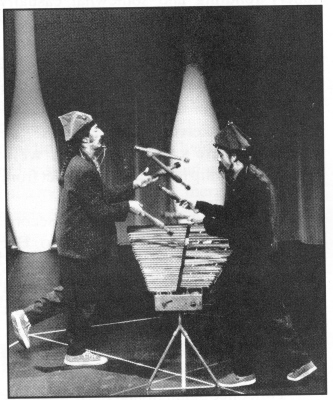
The musical Karamazovs --
Paul and Howard (Saju Joy photo) |
Page 20 Winter 1989 - 90
|
ENTERTAINERS Karamazovs
Offer More Of by
Bill Giduz
The
Karamazov Brothers have
In
a recent Raleigh, N.C., appearance, the group proved to a packed
house they operate just as effectively as a quartet as they did as a
quintet. Randy Nelson has left for employment with Next Computer
company, but Patterson, Paul Magid, Sam Williams and Tim Furst
carryon without missing a beat. As Furst explained, the group has
always done four-person shows when one person needed to be away.
A
handsome new backdrop sets an appropriate tone for the evening.
The
show begins with a demonstration of silent skilI, as the FKB execute
a complicated four-person weave that gets faster and faster without
saying a word.
But
the silence doesn't last long. They follow with three-club, two
person take aways with a rapid patter that recalls the famous Abbott
and Costello "Who's on first?" routine. Music is
introduced as Furst solos with clubs while the others accompany him
hilariously on horns. The audience can't help but giggle as Williams
tries to pick up a dropped sombrero while keeping his tempo on the
tuba.
From
that "Solo" introduction, Patterson and Magid segue into a
"Duo" demonstration of two person club passing while
joking about glasnost, arms reduction and the Karamazov Passing
System. The "war of bodily coordination" escalates to a
promised demonstration of -- get this - simultaneous singing,
marimba playing,
The
"Trio" segment is carried with the theme of "see no
evil, speak no evil, smell no evil," with giant ears as props
and appropriate ape-like movement. Williams begins the tale of their
juggling exploits, which flows into a "Quartet" song a la
Gilbert and Sullivan. The jaunty chorus of "We're the very
model of a modem vaudeville juggling troupe!" may be delivered
in a selfdeprecating, silly style, but many audience members
realize the truth in the message!
Next
the audience gets to challenge Patterson with their wildest offerings
of impossible juggling props. On this particular evening, the
challengers offered up blocks of ice, an inflatable dinosaur, a
Slinky, pancakes, a chain, a sheet cake, tofu and more. The selection
process, buildup, mess-making and final triumph of the champ stretched
on for almost 20 minutes.
It
was on to hardware juggling with sickles, battle axes, Sufi swords and
cleavers -- a routine that left body parts on the floor, blades
embedded in bodies and everyone out for the count. They revived
briefly, however, to deliver a clever intermission sales pitch to the
tune of "Somewhere Over the Rainbow."
The
second act began with the melancholy sight of winos dozing in the
The
"Jazz" club passing routine comes next, with many familiar
gags and a highlight of continuous bounce passes from the others to
feedee Magid, who catches just about everything. Williams provided
constant comedy commentary as the feeder in the middle.
They
end with a buildup of musical juggling demonstrations. High-tech
computerized transmission between sensors on their suits and
amplifiers and synthesizers offstage give the performers the freedom
to move around the stage while still creating
The
demonstration starts with the brothers donning helmets that respond
with musical notes
when struck by clubs. Again, the absurd becomes miraculous as the
Kararnazovs do a four-person weave passing pattem while bashing
themselves in the head with clubs to create the classical tune,
"Ode to Joy."
The
finale includes Williams playing back drums, Furst bouncing |

The musical Karamazovs --
Paul and Howard (Saju Joy photo) |